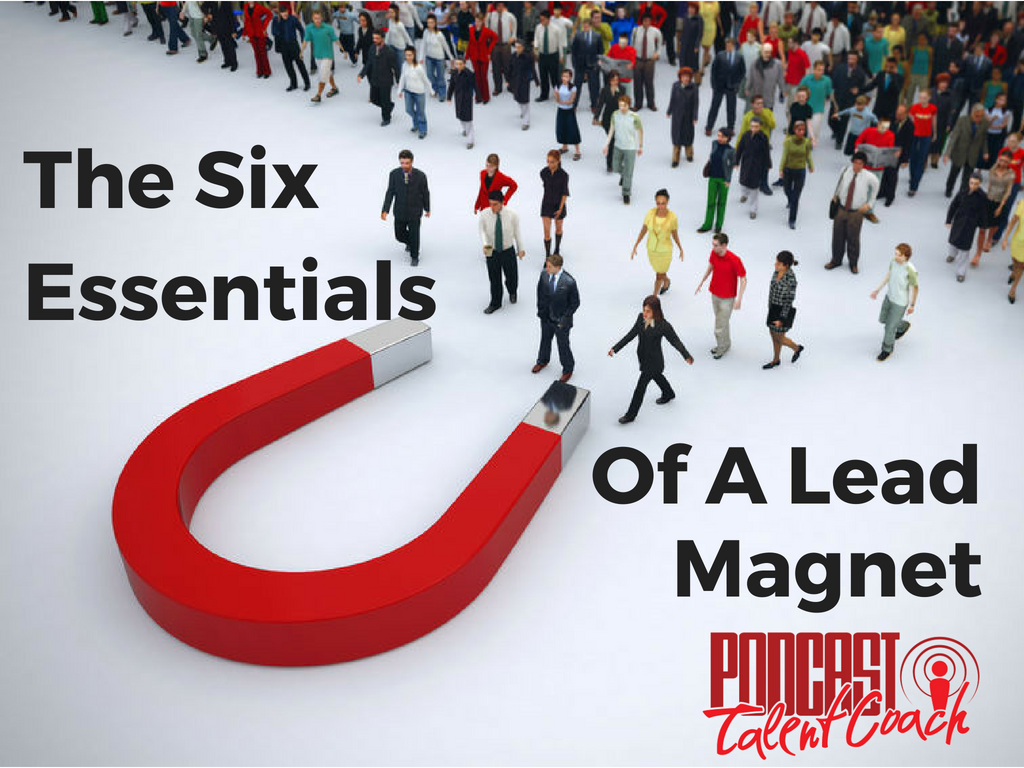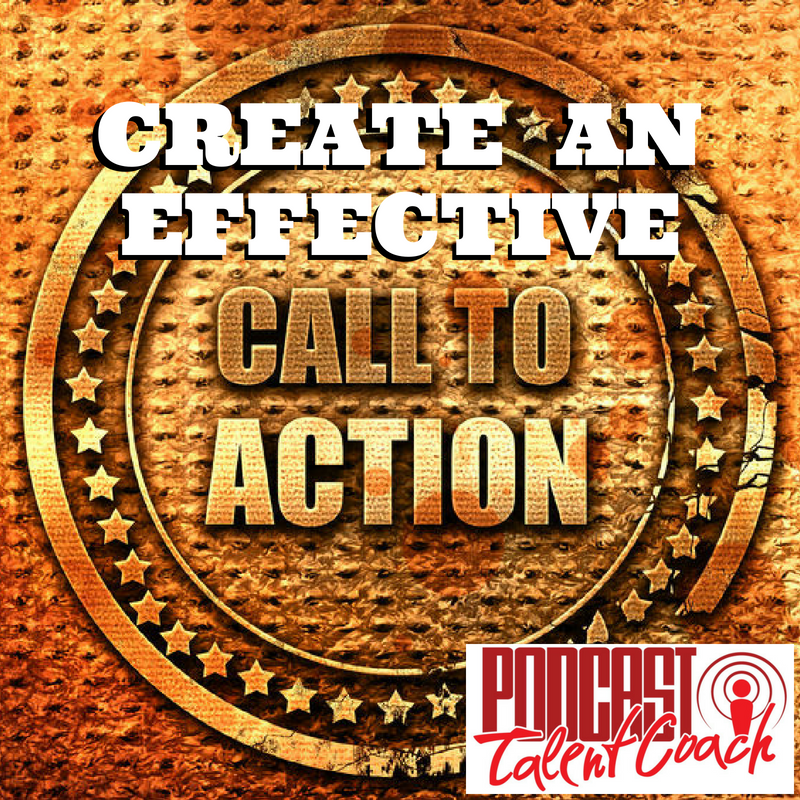Podcast: Play in new window | Download
Subscribe: RSS
The Six Essentials Of A Lead Magnet – Episode 197

Many of my clients and those that join Dave Jackson and me on the Podcast Review Show want to grow their e-mail list. Rather than offering a powerful lead magnet, many of them simply have a “subscribe to my newsletter” button. How often are you hoping somebody will send you another newsletter?
Let’s talk about building a powerful lead magnet that people will actually want. One that will drive your opt-ins.
What is a lead magnet?
Ryan Deiss at Digital Marketer defines a lead magnet as “a small chunk of value that solves a specific problem for a specific market that is offered in exchange for an opt-in.”
By that definition, “subscribe to our newsletter” is NOT a lead magnet.
Your lead magnet is the beginning of your relationship with your listener. Our intention is to eventually make them a customer. By having their e-mail address, you can provide them with some quick value and start building likability and trust.
I love Ryan’s definition, because you can look at your piece of content and know instantly if it is a true lead magnet.
Let’s look at each piece individually.
A SMALL CHUNK
A small chunk means your piece of content is easy to consume. It is small.
This should be a quick report and not a 148 page e-book. I can’t tell you how many free e-books I have saved on my computer that I intended to read, but never got around to it.
My quick count is 47. Very quick, but rough enough for you to get the idea.
I love the idea of getting an e-book. I just never set aside the time to read them. It takes too long. Therefore, I don’t move along the value ladder. The content doesn’t serve its purpose.
Create a lead magnet that offers quick results for one big thing. Give your listener results quickly that will move them along your value ladder and closer to becoming a paying customer.
When I first started creating lead magnets, I created 3 free videos. One is the power of one-to-one communication. One is the difference between marketing to men and women. The third is the power of theater of the mind.
Each video was 30-minutes of some of my strongest teaching. I saw Brendon Burchard release videos like this for his programs. I saw Jeff Walker release videos like this with Product Launch Formula.
What I didn’t realize was their videos were further up the value ladder. These videos were part of their launch sequence. I had already received their lead magnets. We had already started a digital relationship. Their videos were part of their training, not lead magnets.
My 30-minute videos were not successful in gaining opt-ins. I got a few, but nothing like my worksheets.
I offered a Show Prep Planning worksheet. It contains five questions that help you lay out your entire episode. This list is by far my largest list. 90 minutes of video training gets crushed by a checklist with five questions.
Make it easy and quick to consume.
OF VALUE
Do people actually want your piece of free content?
Not only does your lead magnet have value, your customers/listeners/tribe must be able to understand that value. Your lead magnet must have high perceived value.
If I tell you my list of 17 of the Most Powerful Podcast Interview Questions Ever will help you creating one-of-a-kind interviews without hours of preparation, you should be able to understand that it will save you hours of time.
My videos probably had trouble here as well. Long doesn’t necessarily mean valuable.
What will your piece of content do for your listener? Make that benefit and value clear to your listener.
THAT SOLVES A SPECIFIC PROBLEM
Your product will do one of two things. It will give your prospect pleasure or remove a pain. This is often referred to as vitamins or aspirin. When you look at marketing that usually works best, it contains a promise to solve a problem. Aspirin sells better than vitamins.
Your lead magnet should solve one problem. Not 17. One.
That problem should be specific, well-defined and easily understood by your audience.
Shave 3 hours off of your prep time.
Cut your post production in half.
Double your Facebook followers.
Lose 8 pounds in the first week.
Singular and specific.
When you get your listener quick results, you move your prospect up your value ladder. They experience the results quickly. This creates a niche that is very focused on a single problem you can now solve with the rest of your autoresponder series.
FOR A SPECIFIC MARKET
We know the problem. Now, we need to know that target audience. You cannot market your solution to an audience unless you have defined that specific audience with the specific problem.
When we know who they are, we know where to find them. We know what they want, need and desire. We know how to structure our communication. We know the pain points to address.
In radio, clients would often come to us to help create their marketing plan. I met with an owner of a local jewelry store. He was looking for ways to reach an audience he didn’t typically reach with his direct mail and newspaper campaigns.
My first question to radio clients is always, “Who is your target customer.”
This guy tells me, “Our customers are everybody, but mostly people 25- to 54-years-old.”
“Well,” I say, “that’s not a target customer. That is a family reunion.”
The 27-year-old male coming into the store is buying jewelry for a completely different reason than a 52-year-old female. He might be getting married for the first time. She may be looking for a college graduation gift for her daughter.
These two people probably have different budgets, different needs, different pain points, different language and a different sense of humor. You cannot communicate and persuade to both using the same message.
Define your target, so you can tailor your communication.
THAT IS OFFERED
People won’t know about your lead magnet unless you tell them. If you have a lead magnet, offer it to your audience in various ways.
“If you build it, they will come” only happens in the movies.
There are many ways you can get people to your lead magnet.
Tell your audience about your great piece of free content on your podcast.
Use your newsletter to spread the word.
Make sure it is prominent on your website.
When you are giving interviews, tailor the lead magnet to that specific audience.
Post the link on your social media.
If you have a few extra dollars, run some ads. However, only do this once you know the audience wants your lead magnet by testing it through the other methods.
IN EXCHANGE FOR AN OPT-IN
The whole reason we built the lead magnet is to get the e-mail address. Make sure you have set up your e-mail system to collect the addresses.
As you create your opt-in, make it easy. Reduce the number of hoops your listener needs to jump through. This is easier said than done.
When you build the steps, you add in their name and e-mail address and a bunch of other stuff. After the opt-in is complete, step back and look at the entire process. Do you really need all of it? Can you make it easier?
Only collect the necessary info. The easier you make the opt-in, the more success you will have.
LEAD MAGNET IDEAS
Resource kit/tool box.
Report or guide.
Free trial.
Cheat sheet.
Checklist.
Digital Marketer is a great membership. I get so much value from the Execution Plans. If you are looking for help in any aspect of your online business, chances are there is a course inside of Digital Marketer that can help.
Do you need help with your podcast? E-mail me any time at Coach@PodcastTalentCoach.com. Let’s see what we can do.
You can find my podcast and other tools to help you create great content at www.PodcastTalentCoach.com.
Let’s turn your information into engaging entertainment.

